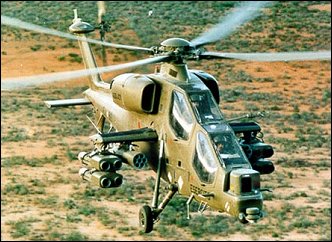|
For dealing with tanks and armoured vehicles, the Mangusta is equipped with a mast- or nose-mounted sight and TOW or Hellfire missiles. It can launch Stinger, Sidewinder, Mistral or Javelin air-to-air missiles against airborne targets and can carry a range of rocket and gun pods to provide fire support for ground troops.
The Mangusta (Mongoose) is also highly automated. A data management system records malfunctions and recommends how they should be repaired. It also controls the various flight and mission subsystems.
The crew consists of co-pilot/ gunner forward and pilot aft. They both use helmet-mounted displays which present targeting information and the imagery from infra-red sensors for operations at night. They also have fly-by-wire controls and multi-function displays showing all flight data.
Italian army A129s were deployed in the peace-keeping role in Somalia. To make the helicopter even more versatile, Agusta has developed the A129 International. This has T800 engines, plus a new drive system, and carries a three-barrelled 20mm cannon under the nose. R.Jackson "Helicopters. Military, Civilian, and Rescue Rotorcraft", 2005

The latest original design to appear from the Agusta stable, the A.129 Mangusta (Mongoose) is a day/ night military scout/antiarmour helicopter, which is expected to enter service with Italian Army Aviation squadrons in early 1986. Preliminary design of the A.129 began in 1978, and the first of four flying prototypes made its initial flight on 15 September 1983.
The A.129 uses a fully-articulated four-blade main rotor system with elastomeric bearings and low-noise profile tips. The fiberglass blades are designed to have a ballistic tolerance against hits from 12.7mm ammunition and considerable tolerance against 23mm hits. The transmission has a run-dry capability. A Harris digital integrated multiplex system controls communication, navigation, engine, armament, power distribution and utility systems. The avionics include active and passive self-protection systems, and the 70 percent composite-built airframe is resistant to 12.7mm ammunition and meets the latest crashworthiness standards. The two crew are seated in a tandem cockpit, fitted with a low-glint canopy and with a small frontal area to minimize visual and radar detection. The powerplant is two Rolls-Royce Gem 2 turbines, license-built in Italy by Piaggio.
A variety of offensive armament can be carried by the A.129 on four stub-wing attachment points, the inner pair being stressed for loads up to 300kg. All four pylons can be elevated 3° and depressed 12°. Typical antiarmour weaponry which can be carried includes eight Hughes TOW or Euro-missile HOT missiles, using a telescopic sight with laser range finder and FLIR for target acquisition, or six Rockwell Hellfires, using a mast-mounted sight, pilot's night vision equipment and integrated helmet and display sighting system.
A total of 66 A.129s had been ordered by the Italian Army by early 1984, when Agusta was also anticipating future orders from the Middle East and South America. G.Apostolo "The Illustrated Encyclopedia of Helicopters", 1984
The A 129 Mangusta (Mongoose) was evolved from the A 109 to provide the Italian army with an anti-armour/attack helicopter. As such it features the classic gunship layout of stepped tandem cockpits, stub wings for the weapons, crashworthy fixed undercarriage and slim fuselage for minimum visual signature.
The first A 129 flew on 15 September 1983, and the first of 60 machines for the Italian army entered service in 1989. The Netherlands will be the next recipient. Further developments under review are a naval variant with nose radar and anti-ship missiles, the LBH battlefield transport with a redesigned fuselage for troops and stretchers and the Tonal, a joint European project with Westland, CASA and Fokker to provide a new-generation battlefield helicopter based on the A 129 airframe. D.Donald "The Complete Encyclopedia of World Aircraft", 1997
FACTS AND FIGURES- Plans for the Mangusta were originally
laid in the mid-1970s, but the first aircraft
did not fly until 11 September 1983. - Development was further delayed by
funding problems for the HeliTOW sight. - A joint European project, known as Tonal,
was to have been based on the A129. - A Lucas chin turret, with a 12.7mm machine-gun, may be fitted, but it
is not used by the Italian army. - The British and Dutch armies bought the
AH-64 in preference to the Mangusta. - Iran has shown interest in ordering
an export version.
| Technical data for Agusta A-129 "Mangusta"
Crew: 2,
engine: 2 x Rolls-Royce Gem 2 Mk. 1004D turboshaft, rated at 615kW,
main rotor diameter: 11.90m,
wingspan: 3.20m,
length with rotors turning: 14.29m,
fuselage length: 12.28m,
height: 3.35m,
take-off weight: 4100kg,
loaded weight: 2529kg,
max speed: 259km/h,
rate of climb: 10.9m/s,
hovering ceiling, OGE: 3105m,
endurance: 3h,
armament: 8 Tows or 6 Hellfires
|
Warning: mysqli_connect(): php_network_getaddresses: getaddrinfo for mysql5.zone.ee failed: Name or service not known in /data03/virt15346/domeenid/www.aviastar.org/htdocs/helicopters_eng/agusta_mangusta.php on line 116
Fatal error: Uncaught mysqli_sql_exception: php_network_getaddresses: getaddrinfo for mysql5.zone.ee failed: Name or service not known in /data03/virt15346/domeenid/www.aviastar.org/htdocs/helicopters_eng/agusta_mangusta.php:116
Stack trace:
#0 /data03/virt15346/domeenid/www.aviastar.org/htdocs/helicopters_eng/agusta_mangusta.php(116): mysqli_connect('mysql5.zone.ee', 'd14657sa18989', Object(SensitiveParameterValue))
#1 {main}
thrown in /data03/virt15346/domeenid/www.aviastar.org/htdocs/helicopters_eng/agusta_mangusta.php on line 116
| 




